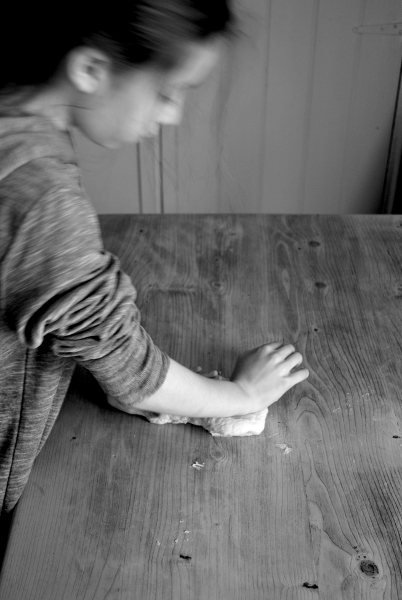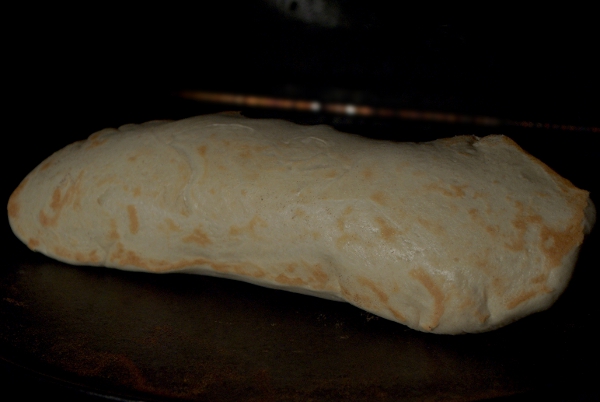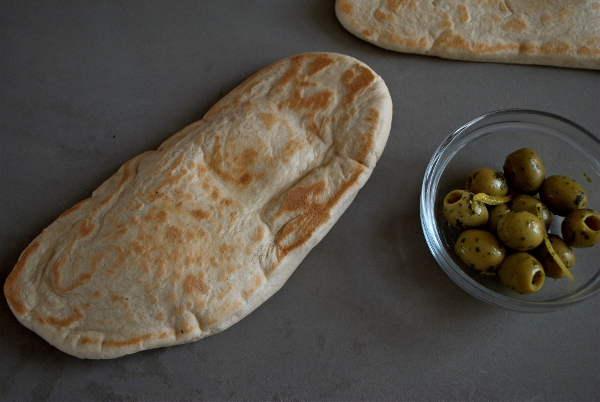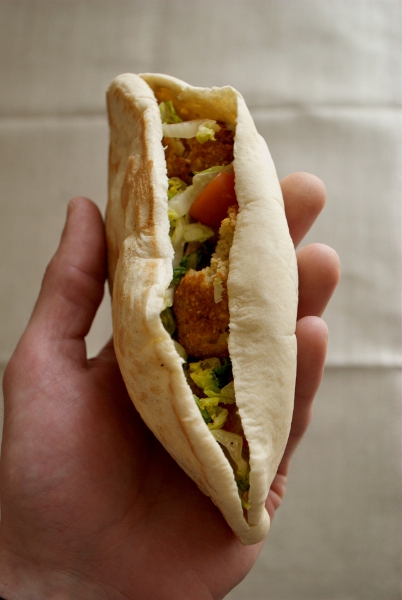Pita pocket (or two)
Pita bread has to be one of the easiest and quickest yeasted breads to make. In terms of quality, the bar is set so low by commercially made pita that you can hardly fail to be satisfied with the results: the difference between a shop-bought and a home-made pita can be pretty dramatic. Furthermore, there is something particularly satisfying about the swift transformation of an unremarkable sliver of dough into a puffy envelope of pita. For all these reasons, it’s the perfect bread to make with children. My eldest daughter Lola, who is already a proficient baker of cupcakes, helped me out with a Middle Eastern lunch over the weekend. People sometimes think there must be some obscure technique or process involved in creating a flatbread that magically parts to accept a filling, like a ready-made sandwich. In fact, this characteristic is simply a product of the shape and size of the dough. One of the reasons bread rises rapidly in the heat of the oven is that some of the water in the dough turns to steam, which naturally escapes and causes outward force as it does so. Because pita is thin, and also because individual pitas are relatively small, the steam causes the dough to puff up like a balloon, separating the outer surfaces. To make really successful pita, the dough must be thin (no thicker than 5mm) and not too large (a diameter of between 15 and 25cm is ideal). Having said that, it’s not difficult to get it right and results can usually be measured in degrees of success rather than in terms of success and outright failure.
People sometimes think there must be some obscure technique or process involved in creating a flatbread that magically parts to accept a filling, like a ready-made sandwich. In fact, this characteristic is simply a product of the shape and size of the dough. One of the reasons bread rises rapidly in the heat of the oven is that some of the water in the dough turns to steam, which naturally escapes and causes outward force as it does so. Because pita is thin, and also because individual pitas are relatively small, the steam causes the dough to puff up like a balloon, separating the outer surfaces. To make really successful pita, the dough must be thin (no thicker than 5mm) and not too large (a diameter of between 15 and 25cm is ideal). Having said that, it’s not difficult to get it right and results can usually be measured in degrees of success rather than in terms of success and outright failure. A simple dough made with flour (white, or a combination of white and wholemeal, according to your taste), water, yeast and a little salt, is all you need for pita. About 60% water by weight of flour makes a dough that is easy to roll out without sticking. Although many breads benefit from a higher proportion of water, there is really no point with a very flat bread like this. You don’t even need to prove the dough – an hour or so’s bulk fermentation is enough before you roll it out into rounds or ovals. An average size pita requires about 50g of dough. Flatten the dough by pressing down on it with a rolling pin, then roll it out using plenty of pressure. Even with a 60% hydrated dough, a dusting of flour on the worksurface and rolling pin is a good idea. Get your oven as hot as you can, and use a baking stone if you have one. Place the dough directly on the stone (or on a pre-heated baking sheet if you lack one) and give it a couple of minutes to puff up before turning it over and giving it another couple of minutes.
A simple dough made with flour (white, or a combination of white and wholemeal, according to your taste), water, yeast and a little salt, is all you need for pita. About 60% water by weight of flour makes a dough that is easy to roll out without sticking. Although many breads benefit from a higher proportion of water, there is really no point with a very flat bread like this. You don’t even need to prove the dough – an hour or so’s bulk fermentation is enough before you roll it out into rounds or ovals. An average size pita requires about 50g of dough. Flatten the dough by pressing down on it with a rolling pin, then roll it out using plenty of pressure. Even with a 60% hydrated dough, a dusting of flour on the worksurface and rolling pin is a good idea. Get your oven as hot as you can, and use a baking stone if you have one. Place the dough directly on the stone (or on a pre-heated baking sheet if you lack one) and give it a couple of minutes to puff up before turning it over and giving it another couple of minutes. The flat dough will inflate like a balloon as it fills with steam, which is fun to watch. Of course, the steam escapes fairly quickly, and the bread will deflate: by this time, though, it is almost baked through and the formation of the characteristic pocket is complete. Although they take up a fair bit of room in the oven, pita bake so quickly that you can produce quite a few in a short space of time.
The flat dough will inflate like a balloon as it fills with steam, which is fun to watch. Of course, the steam escapes fairly quickly, and the bread will deflate: by this time, though, it is almost baked through and the formation of the characteristic pocket is complete. Although they take up a fair bit of room in the oven, pita bake so quickly that you can produce quite a few in a short space of time.
Pita is found in regional cuisines from North Africa to India, but is strongly associated with the Middle East, in particular the region of the eastern Mediterannean called the Levant, although the word itself derives from Greek. For our lunch we ate our pita stuffed with home-made felafel, hummos and salad, accompanied by baba ghannouj (a smoky aubergine dip) and olives.
 If you’ve tried making bread before and have been disappointed, pita is a good way to build your confidence. If you’re already an experienced baker…well, you don’t need me to tell you how good this simplest of breads can be.
If you’ve tried making bread before and have been disappointed, pita is a good way to build your confidence. If you’re already an experienced baker…well, you don’t need me to tell you how good this simplest of breads can be.
